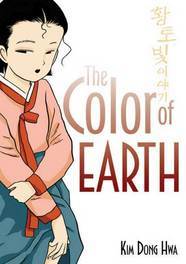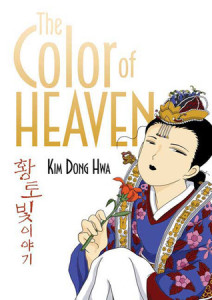THE STORY OF LIFE ON THE GOLDEN FIELDS, VOL. 1-3
Kim Dong Hwa (trans. Lauren Na, First Second, 2003) ISBN: 978-1-59643-458-5; 978-1-59643-459-2;  978-1-59643-460-8
978-1-59643-460-8
Kim Dong Hwa’s The Story of Life on the Golden Fields is a series of three gorgeous manhwa (Korean graphic novels and comic books), telling the story of Ehwa and her widowed mother as they wait for love. Based on the life of Kim Dong Hwa’s mother, it is set in a rural Korean village and has a timeless feel to it. Slow-moving and elegant, the books are part coming-of-age and part love story.
In the first book, The Colour of Earth, we are introduced to Ehwa and her mother, who runs the village tavern. As the years and seasons pass, Ehwa transforms from a very young girl into a young woman, learning about love and sexuality from the world around her. She falls in love with two men, but does not know how to deal with both of them, or how to react to her feelings. Meanwhile, Ehwa’s mother endures the taunts and flirting of the village men until a travelling artist arrives as a guest. She falls in love with him, but his profession prevents him from remaining in the village and he can only return once a year. Slowly, the tavern begins to flourish and Ehwa’s little family becomes better off.
 The second book, The Colour of Water, watches both Ehwa and her mother as they wait for their loves. One of Ehwa’s crushes is forced to leave for the seaside, and her mother’s lover is travelling. Lecherous Master Cho seeks Ehwa out to marry through a match-maker. This book is one primarily of longing. Usually I would find this sort of story irritating, but Ehwa and her mother are not helpless while they wait for their lovers. Instead they continue to live their lives, improving the tavern and enjoying moments together as mother and daughter.
The second book, The Colour of Water, watches both Ehwa and her mother as they wait for their loves. One of Ehwa’s crushes is forced to leave for the seaside, and her mother’s lover is travelling. Lecherous Master Cho seeks Ehwa out to marry through a match-maker. This book is one primarily of longing. Usually I would find this sort of story irritating, but Ehwa and her mother are not helpless while they wait for their lovers. Instead they continue to live their lives, improving the tavern and enjoying moments together as mother and daughter.
The Colour of Heaven brings happy endings in several senses. Ehwa is married to her beloved and her mother, too, receives happiness as her lover settles down with her. While the message that a woman needs marriage, or even a romantic interest, to be fulfilled in life, irritates me profoundly, I loved this book. The illustrations are wonderful. You can set aside the  knowledge that such stories ultimately harm women by depicting them as less than whole without a man and enjoy the story of these two women in particular. It is a rare story that can be decontextualized in such a manner and I think it speaks to Kim Dong Hwa’s skill in creating this timeless world.
knowledge that such stories ultimately harm women by depicting them as less than whole without a man and enjoy the story of these two women in particular. It is a rare story that can be decontextualized in such a manner and I think it speaks to Kim Dong Hwa’s skill in creating this timeless world.
If you can find it, I would recommend you seek out and read The Story of Life in the Golden Fields. It is a moving and excellently illustrated story.

